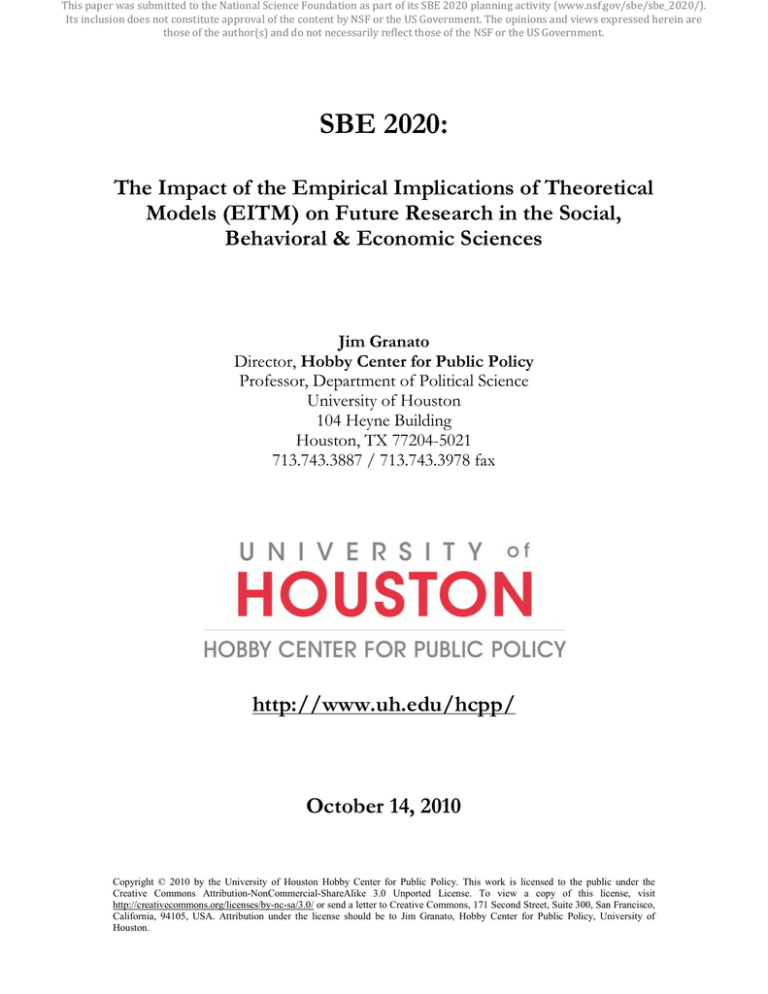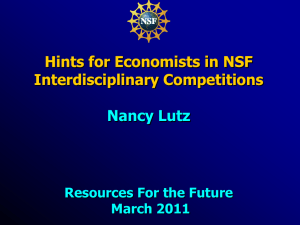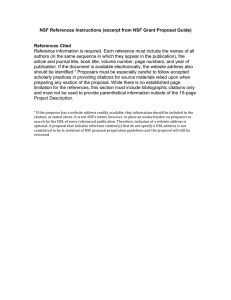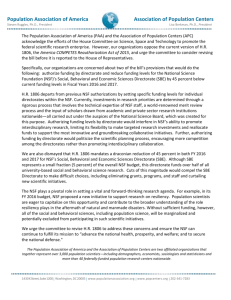Document 14233105
advertisement

This paper was submitted to the National Science Foundation as part of its SBE 2020 planning activity (www.nsf.gov/sbe/sbe_2020/). Its inclusion does not constitute approval of the content by NSF or the US Government. The opinions and views expressed herein are those of the author(s) and do not necessarily reflect those of the NSF or the US Government. SBE 2020: The Impact of the Empirical Implications of Theoretical Models (EITM) on Future Research in the Social, Behavioral & Economic Sciences Jim Granato Director, Hobby Center for Public Policy Professor, Department of Political Science University of Houston 104 Heyne Building Houston, TX 77204-5021 713.743.3887 / 713.743.3978 fax http://www.uh.edu/hcpp/ October 14, 2010 Copyright © 2010 by the University of Houston Hobby Center for Public Policy. This work is licensed to the public under the Creative Commons Attribution-NonCommercial-ShareAlike 3.0 Unported License. To view a copy of this license, visit http://creativecommons.org/licenses/by-nc-sa/3.0/ or send a letter to Creative Commons, 171 Second Street, Suite 300, San Francisco, California, 94105, USA. Attribution under the license should be to Jim Granato, Hobby Center for Public Policy, University of Houston. This paper was submitted to the National Science Foundation as part of its SBE 2020 planning activity (www.nsf.gov/sbe/sbe_2020/). Its inclusion does not constitute approval of the content by NSF or the US Government. The opinions and views expressed herein are those of the author(s) and do not necessarily reflect those of the NSF or the US Government. ABSTRACT On October 29, 2009, the Political Science Program of the National Science Foundation NSF) convened a Workshop (SES-0956812) to evaluate the progress that the Empirical Implications of Theoretical Models (EITM) initiative – the program to unify formal and empirical analysis – had made since it was first introduced in 2002. More importantly, given that funding for all EITM initiatives end in the summer of 2010 it was deemed appropriate to determine whether to make EITM a continuing focus of the Political Science Program at NSF – and to consider whether to extend the initiative to other social science disciplines . The interdisciplinary Workshop participants found the EITM initiative to be “one of the best things NSF has done” and that it has been “money well spent.” They unanimously agreed that the EITM initiative should continue within political science but also expand to other social science disciplines. In their commentaries, Workshop participants identified the following achievements of the EITM initiative and its goals for the upcoming years. A copy of the 2010 report can be found at the following: (http://www.uh.edu/hcpp/EITMWorkshopREPORTFINAL.pdf). In this white paper we highlight the EITM motivation, training and integration challenges, and future initiatives suitable for transforming the social sciences by 2020. 2 This paper was submitted to the National Science Foundation as part of its SBE 2020 planning activity (www.nsf.gov/sbe/sbe_2020/). Its inclusion does not constitute approval of the content by NSF or the US Government. The opinions and views expressed herein are those of the author(s) and do not necessarily reflect those of the NSF or the US Government. I. Motivation At its most elementary level EITM is a framework to unify formal and empirical analysis. 1 This type of methodological unification is not new in the social sciences. It can be traced back to the accomplishments of the Cowles Commission. 2 At least four scientific issues motivated the creation of EITM at NSF. The first issue is that the ultimate focus of a model and test should be to support a cumulative scientific process geared toward finding causal mechanisms. Specifying a model that links both formal and empirical approaches alerts researchers to outcomes when specific conditions are in place – and it is also one of the best ways to determine an identified causal relation. A second issue is that the status quo in political and social sciences is the methodological isolation of fields and sub-fields. Among the consequences of this isolation is the schism between formal and empirical modeling and the concomitant weaknesses in how social science researchers specify and test their models. The third issue follows the second: not only are the various fields in political and social sciences isolated methodologically, but also substantively. EITM-type collaborations in education, knowledge dissemination, and research organized around specific issues (e.g., climate change, energy, inequality) can promote interdisciplinary interactions and improve the quality and depth of knowledge in each field. The EITM framework is inspired by the original work of the Cowles Commission in the field of economics but it is meant to strengthen and advance research in all social science disciplines. Fourth, despite a focus by numerous social science disciplines on interactions between agent behavior and public policies, the current research practices can fail to develop formal models of such behavior. If one were to strictly adhere to the Cowles Commission approach we would, for example, forego the chance of modeling new uncertainty created by shifts in behavioral traits (e.g., public tastes, attitudes, expectations, and learning). EITM places emphasis on finding ways to model human behavior and action and, thereby, aids in creating realistic representations that improve upon simple socio-economic categorization. II. Implementation Challenges Workshop participants in written and spoken commentaries cited implementation barriers. These challenges take several forms which are sourced: See Granato, Lo, and Wong (2010) for a description and examples of the EITM framework. Created in the 1930s, the Cowles Commission was designed “to foster the development and application of rigorous logical, mathematical, and statistical methods of analysis” for application in economics and related social sciences. (See http://cowles.econ.yale.edu/about/index.htm ). 1 2 3 This paper was submitted to the National Science Foundation as part of its SBE 2020 planning activity (www.nsf.gov/sbe/sbe_2020/). Its inclusion does not constitute approval of the content by NSF or the US Government. The opinions and views expressed herein are those of the author(s) and do not necessarily reflect those of the NSF or the US Government. • • • • • • • • lack of cooperation between disciplines. lack of linkage between summer institutes and applied statistical methods entities. few incentives to motivate tenured faculty to try new methods. strong resistance from departments which have an empirical modeling tradition. reticence from students against complicated formal and behavioral models. insufficient training in formal modelling. lack of interest from students who don’t have training in formal modelling. resistance from reviewers and journal editors caused by specialization on only formal or empirical work, not on both. The sources of resistance are not surprising. EITM Workshop participants (in the past and current workshops) noted the resistance to unifying formal and empirical modeling was due to several factors. Among those factors were: 1. The Intellectual Investment: the intellectual investment needed for formal modeling is different than the knowledge needed for empirical modeling. As such, scholars have to invest in different skill sets. 2. Training Differences: Empirical modelers devote their energies to data collection, measurement, and statistical matters, while formal modelers center on mathematical rigor. 3. Research Practice: For empirical modelers, model failures lead to emphasis on more statistical training or more sophisticated uses of statistics – usually to “patch over” – a model failure. Formal modelers, on the other hand, deal with model controversies by considering alternative mathematical formulations but this is usually done piecemeal. However, the one similarity between these two approaches is that both formal and empirical modelers tend to remain tied to their particular technique despite the warning signals evidenced in model breakdown. These implementation challenges are deeply rooted in the academic community and will take years to overcome. However, the EITM progress accomplished since 2002 shows that a gradual change is possible and should continue and expand. III. Reorientation in Training While the previous section indicated the challenges EITM poses for reorientation of training, the 2009 EITM Workshop participants also discussed how the transformative nature and the significant scientific benefits offered by EITM may help overcome them. The importance of using EITM to spur training reorientation and integration within and between disciplines cannot be overstated. Establishing formal and empirical modeling competency in training in the social sciences is a necessity. Without that foundation any substantial progress in social science research will be limited. Fortunately, one social science discipline, economics, has been successful in 4 This paper was submitted to the National Science Foundation as part of its SBE 2020 planning activity (www.nsf.gov/sbe/sbe_2020/). Its inclusion does not constitute approval of the content by NSF or the US Government. The opinions and views expressed herein are those of the author(s) and do not necessarily reflect those of the NSF or the US Government. technical training and may serve as a guide for other disciplines to build foundational courses that would foster EITM integration . 3 Formal and empirical training in economics has the following characteristics: 1. Economics graduate students are required to take one full year (usually) of mathematics for economists. 2. This mathematical (and quantitative) approach is reinforced in substantive courses which typically are taught as an analytic science in a theorem-proof mode. 3. Mathematical (quantitative) competency in most economics graduate programs is demonstrated not only in these foundational courses, but also in qualifying examinations in the summer after the first year of coursework. 4. Students must clear this hurdle before being allowed to proceed with their Ph.D. The 2009 Workshop participants also discussed providing training options for faculty who could use their new tools for both research and teaching purposes, and acknowledged that support would be necessary, particularly for junior faculty. However, several discussants expressed concerns about “old habits” learned in graduate school that would inhibit the desire to make the changes in skill development and suggested that resources were better spent on graduate students. IV. Social Science Integration Because of its very nature, EITM-inspired linkages between formal and empirical analysis can lead to collaborations in education, knowledge dissemination, and research. Research groups might include political scientists together with anthropologists, economists, sociologists, experimental psychologists, and computer scientists. 2009 Nobel Laureate in Economics, Lin Ostrom – a supporter of EITM – has created a decades-long body of research that is known for its integration of various social science disciplines and their tools (see Poteete, Janssen, and Ostrom 2010). EITM-inspired collaboration can also help unify the vocabulary used for analyzing a problem in various disciplines. 4 An additional benefit of collaboration is enhancing research designs in the involved disciplines, as evidenced by Ostrom’s work. While the economics training regimen is an important and successful model for technical training it was noted by Workshop participants that it does share the same “siloing” problems that other social science disciplines experience. 4 See Jasso (2008) for an example of EITM-type research in Sociology. 3 5 This paper was submitted to the National Science Foundation as part of its SBE 2020 planning activity (www.nsf.gov/sbe/sbe_2020/). Its inclusion does not constitute approval of the content by NSF or the US Government. The opinions and views expressed herein are those of the author(s) and do not necessarily reflect those of the NSF or the US Government. V. Priorities Funding priorities, where NSF has played a role in the past, are intended to enhance training and research reorientation, unify scientific knowledge, as well as integrate a common social scientific language . EITM Workshop participants recommended several components that can be classified along three areas: I. II. III. Human Capital Development Curriculum Reorientation Infrastructure Enhancement For the priorities listed, NSF can, for example, assist in the following ways. • • • • NSF can help develop EITM courses and facilitate their systematic inclusion in university curricula. To motivate scholars to adopt this initiative, NSF can include EITM components in requirements for NSF fund proposals. Current NSF budgets for infrastructure development can be used for EITM visualization technologies and human resource development for multi-disciplinary EITM workshops. The NSF can provide additional funding for the EITM Summer Institutes, for setting up the EITM Web site, and for monitoring EITM success. Va. Human Capital Development To address the skills deficit, support can be provided for 1) graduate training, 2) postdoctoral opportunities, and 3) mid-career re-tooling. Such support can include courses in formal and empirical modeling, experimental methods (which link formal and empirical tools), and courses that link visualization tools that enhance model and test development. Graduate student options in human capital development could include: • • Support for an additional year or two of graduate school to complete both formal and empirical modeling sequences. Support for summer training institutes. One new area would be to focus on having multi-disciplinary EITM Summer Institutes that have simultaneous modules for the separate disciplines, but also provided that all disciplines meet every week to discuss avenues to devise and learn a common scientific vocabulary. In one participant’s experience, such a course has enabled the reorientation of the home institution’s training. Faculty options in human capital development could include: • • Support for mid-career, ideally post-tenure EITM training. Support for faculty to visit another department on campus or another institution. 6 This paper was submitted to the National Science Foundation as part of its SBE 2020 planning activity (www.nsf.gov/sbe/sbe_2020/). Its inclusion does not constitute approval of the content by NSF or the US Government. The opinions and views expressed herein are those of the author(s) and do not necessarily reflect those of the NSF or the US Government. • Provide for a specific CAREER competition that requires training and teaching along EITM lines. For both faculty and graduate students support could be provided for: • The creation of an EITM society with periodic meetings. Vb. Curriculum Reorientation To advance new developments in technical training, Workshop participants suggested the following: • • • • Support at the department level with Dean approval for any of the following: o Capstone courses that integrate formal and empirical modeling prerequisites. o New syllabi in either formal or empirical modeling that also incorporate elements of EITM. Support for annual workshops where faculty and students from around the country gather to create and revise new syllabi. Support for annual multidisciplinary workshops where faculty and students from at least three disciplines within a university (or from around the country) gather to create and revise new syllabi. Inclusion of a data gathering component in EITM – because new technologies have an impact on theoretical implications, the curricula should reflect the fact that theory should guide data collection. Vc. Infrastructure Enhancement EITM-related research activities can be supported in ways that provide linkages to the infrastructure needs of the social sciences over the next decade. Physical infrastructure support would include: • Shared – multidisciplinary and multi-scholar facilities – that allow for formal and empirical studies, for cohort and peer-based interaction organized around a central research question, and also for experimental research and pilot studies made with very fast turnaround to the scholars involved and the scholarly community at large. It would bring together faculty of all levels including graduate students, post-doctoral students, junior and senior faculty. 5 These types of facilities will be required to pick one problem or theme of study. They should also include representatives from different theoretical (deductive and inductive) frameworks to explain the problem. A contingent of young scholars will also be encouraged. Data fusion and data visualization are particularly important for enhancing communication and eventual collaboration with, for example, computer scientists and engineers. 5 7 This paper was submitted to the National Science Foundation as part of its SBE 2020 planning activity (www.nsf.gov/sbe/sbe_2020/). Its inclusion does not constitute approval of the content by NSF or the US Government. The opinions and views expressed herein are those of the author(s) and do not necessarily reflect those of the NSF or the US Government. Virtual infrastructure involves the following: • The creation and continued development of interdisciplinary web sites that will be based on an EITM membership. The web sites may also build upon existing infrastructure (e.g. HNET). The EITM web sites would include: o o o o o o o List of members. Templates of EITM papers. Archive of published articles using EITM. Chat room for problem solving and tutorials. Computer program archive. Communication of ongoing EITM events. The new revised EITM syllabi. VI. Future Impact on Science, Policy, and Society A goal in the 2009 Workshop was to find ways to make the initiative extend to other disciplines and also solidify a lasting change so that social scientists will consider it natural to unify formal and empirical analysis in their research designs. Or to put it another way, true change will have been reached when the social scientists are viewed in this light by other “hard” sciences and the word EITM is no longer mentioned. EITM-inspired efforts that lead to greater cooperation between the various sciences can enhance policy acumen and aid society. The old way of conducting policy research, where integration between the social sciences, natural sciences, and engineering is rare, can lead to inaccurate predictions and policy failure. Ignoring behavioral responses will have negative ramifications for public policies regarding energy (i.e., the smart grid), education, health, and many other policy areas where human response is involved. Indeed, among the most important broader impacts of EITM --- and one with the most lasting consequence --- will be simply raising awareness of the complexities and challenges to modeling and testing human response. 8 This paper was submitted to the National Science Foundation as part of its SBE 2020 planning activity (www.nsf.gov/sbe/sbe_2020/). Its inclusion does not constitute approval of the content by NSF or the US Government. The opinions and views expressed herein are those of the author(s) and do not necessarily reflect those of the NSF or the US Government. References Granato, Jim., Melody Lo, and M. C. Sunny Wong. 2010. “A Framework for Unifying Formal and Empirical Analysis.” American Journal of Political Science 54, 3: 783-797. Jasso, Guillermina. 2008. “A New Unified Theory of Sociobehavioural Forces.” European Sociological Review 24, 4: 411-434. Poteete, Amy. R., Marco A. Janssen, and Elinor Ostrom. 2010. Working Together: Collective Action, the Commons, and Multiple Methods in Practice. Princeton University Press: Princeton, New Jersey. 9




